Research Division
Reprinted from "INSULATORS - Crown Jewels of the Wire",, December 1970, page 14
From Judy Stapf:
I think I have a ceramic insulator of some
type. It may not be old, but it was found in a long abandoned corn
crib. Perhaps I'd find it in any good hardware store, but before my three
year old break it, I'd like to be sure. Any ideas?
 These
are most commonly known as antenna insulators and come in all sizes, colors and
variety of shapes. Also made in glass in various sizes and colors.
- Editor These
are most commonly known as antenna insulators and come in all sizes, colors and
variety of shapes. Also made in glass in various sizes and colors.
- Editor
Portion of letter from Marie Russell:
My husband and I have been collecting insulators
(the hard ways!) for about 5 months, and although our collection isn't too
large, we have found some that may be of interest to your research department or
readers.
We have found several varieties of old
Brookfield ponies along with a couple of Cauvets and an old Fulton St.
toll along an abandoned line (Fig. 2); a (CD 134) Pettingell Andrews dark
aqua signal (wide groove) in an old Boise dump (our first insulator find);
several color varieties of small Star signals and a baby Star (dk. aqua), and a
beehive Star; a small, threadless opaque glass, seam-over-dome No Name insulator
with marble-like swirls of blue on yellow with a molded hole in the side for a
nail (?) (found in a Boise dump last used in 1931) (Fig. 1); a green, dripless
BBOOKFIELD (embossed error) of the (CD 152) hoopskirt shape (it was the only one
found in about a dozen regular-embossed types of the same color and shape from
the same area); a No Name light aqua signal with PATENT DEC. 19, 1871 on one
side of the skirt; an aqua toll W.U. / 5 (front skirt) -- PATENT / DEC. 19, 1871
/ B (back skirt); a sage (not smoky) California (CD 152) "hoopskirt";
a dark aqua (CD 160) baby signal BROOKFIELD (front skirt) NEW YORK (back skirt);
a (CD 280) HEMINGRAY / PATENT MAY 2 1893 (front skirt), HIGH VOLTAGE / TRIPLE
PETTICOAT / No. 1 (back skirt) with a top like a two-piece transposition
"knob", in dark aqua with sharp drips (Fig. 3); and a power
triple petticoat similar to the Hemingray power described above only with a
signal type of top instead of a "knob", embossed (CD 287) LOCKE VICTOR
N.Y. (front skirt), No. 15 (crude "5" on back skirt) without drips in
dark greenish aqua (Fig. 5).
 |
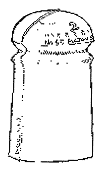 |
 |
 |
 |
| Fig.
1
|
Fig.
2
|
Fig.
3
|
Fig.
4
|
Fig. 5
|
We are also collecting ceramic insulators
and have found a Thomas, Locke (strain type), and two with an "B"
inside a circle embossed on the dome. The rest are No Names, including one
odd cone-shaped insulator 5" tall and with 1" to 1/2" thick
porcelain walls and glazed on the outside and on the inside of the 3/4"
diameter threadless hole (running down through the center from top to bottom)
with a beautiful red and reddish-brown glaze
In regard to Fig.
1. Is this an insulator? I
have been told that it is an old ash tray that at one time had a rubber suction
cup attached and was used on dashboards of the older cars. --- Editor
From Kent Eubanks:
I have an insulator (I think) that I would like
to know just exactly the what, how and for about. The top or front is
embossed "The Gamewell F.A. Tel. Co., 19 Barclay St., NY., Patent Applied
For." I feel that it is possibly some type of equipment insulator.
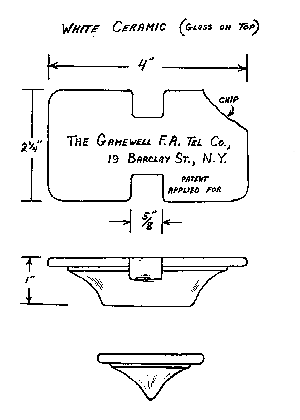
From Jeff Mudge:
Recently I received in a trade a (CD 187) Brown patent insulator, the patent for
which is shown in J. C. Tibbits' book Number 3, page 25. The fellow I traded with
has one more, but other than these two, I have neither seen nor heard of any others
anywhere. Can anyone help me?
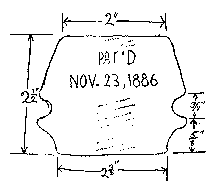 Blue aqua, threads
entirely through insulator, no drip points. Blue aqua, threads
entirely through insulator, no drip points.
These aren't one of the commonest insulators, yet they are not real rare either. We
have five different styles or embossings including the California thru-hole
(or Calif. freak). Any Brown's Patent is a most desirable insulator for your
collection. -- Editor
Letter from Bob Bretschneider:
Thought you might be interested in a new type of insulator that I picked up
a few weeks ago. It is called a "Trolley Feeder Insulator" and is made of malleable iron,
with the insulation on the inside!! It was made by the Ohio Brass Co.
I contacted Mr. T. H. Sawyer of the Ohio Brass Co., with a request for information
on this insulator. He forwarded not only a personal letter, but photostat copies from
the old catalogs, showing original drawings, dated 8-7-99 and when the drawings were redrawn in 9-14-15. Our thanks to Mr. Sawyer for doing such a good
job of aiding us collectors, with this invaluable information.
Description: measures 3.3/4" x 4.3/4" to top of ears. Malleable iron, cable type,
insulation in underbody, composed of material called "Dirigo" (pat. 0. B. Co.) composed of Asbestos and shellac. In the 1915 model the name Flecto
appears on the skirt in 1/4" high letters. After cable is placed in insulator, "ears"
may be beaten
over to secure cable, eliminating need for line ties. The older insulator that I have is
slightly larger than the Flecto, but same materials, and has an embossed # 570 on the
side of the dome under the ears. I cannot quite make out what appears to be a trademark on the skirt. It resembles the triangle trademark that
Whitall-Tatum uses. Don't know if this is an 0. B. (Ohio Brass) or not. If anyone has any information on
this type, please contact me and we can get together and possibly clarify this type of
insulator.
Years ago when I was a Lineman on the Brooklyn Trolley car system, I remembered using this type of insulator. It used a cast iron tapered pin, which in
turn fitted into a cast iron cross-arm with tapered holes. The cross-arm came in two halves
and was bolted onto the steel trolley poles with four large bolts, and came in either single,
double or triple holes on each half. So as many as six feeders could be installed on
one pole.
Letter to Bob Bretschneider from T.H. Sawyer, Mining Products Manager, The
Ohio Brass Company
August 27, 1970
The feeder wire Insulator referred to in your recent letter is our Cat. #8646. This insulator
was originally made In 1899 and is still on an active drawing although we have had no
sales in the last few years. Establishing the age of the actual piece in your possession is
rather difficult. I am enclosing copies of our drawings #388 and #9851 in the hope that our
change notices will give you some clue as to the insulator's actual age . The word
"flecto" apparently appeared on this casting only after drawing #388 war redrawn in
1916. As a result I would assume that your insulator was not made until after 1916.
As far as the insulation material is concerned we have always used the trade-name
Dirigo. Prior to 1939 this material would have been a shellac asbestos base. Due to procurement
problems on shellac during World War II we began to produce two Dirigo compounds
one the shellac asbestos base and the other a cumar asbestos base. As a result, until 1952
either material might be used. After 1952 our Dirigo was changed to a styrene asbestos
base. I hope that with this information you will be able to Identify the insulator as far as
age and material are concerned. For your further information I am also enclosing a copy of
page 192 from our Catalog No. 21 printed In 1934. This page carries a description of our
Catalog #8646 insulator.
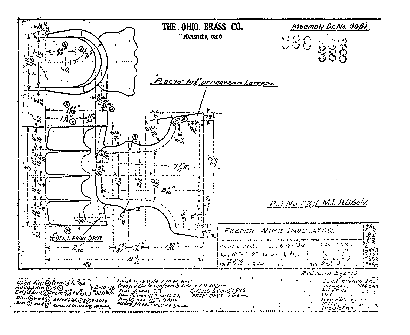
Letter from Grant Barnes:
This insulator was found in an excavation where
the old Edison General Electric Plant was located in Schenectady, N.Y. I
believe it is one of the first power insulators made, and I wondered if anyone
has seen others like it or can identify it further. A drawing of the brass
pin used with this insulator is included below because it is such a different
type of pin.
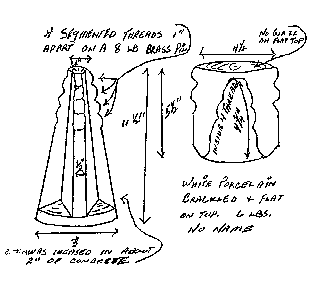
Drawing send by Ed Saulsbury:
Here is a sketch of one of the more uncommon CD
110 Brookfields (at least uncommon on the West Coast).
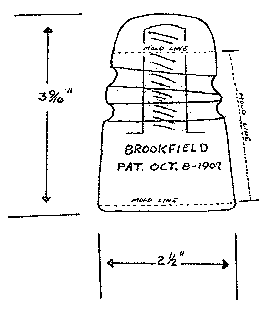
|
